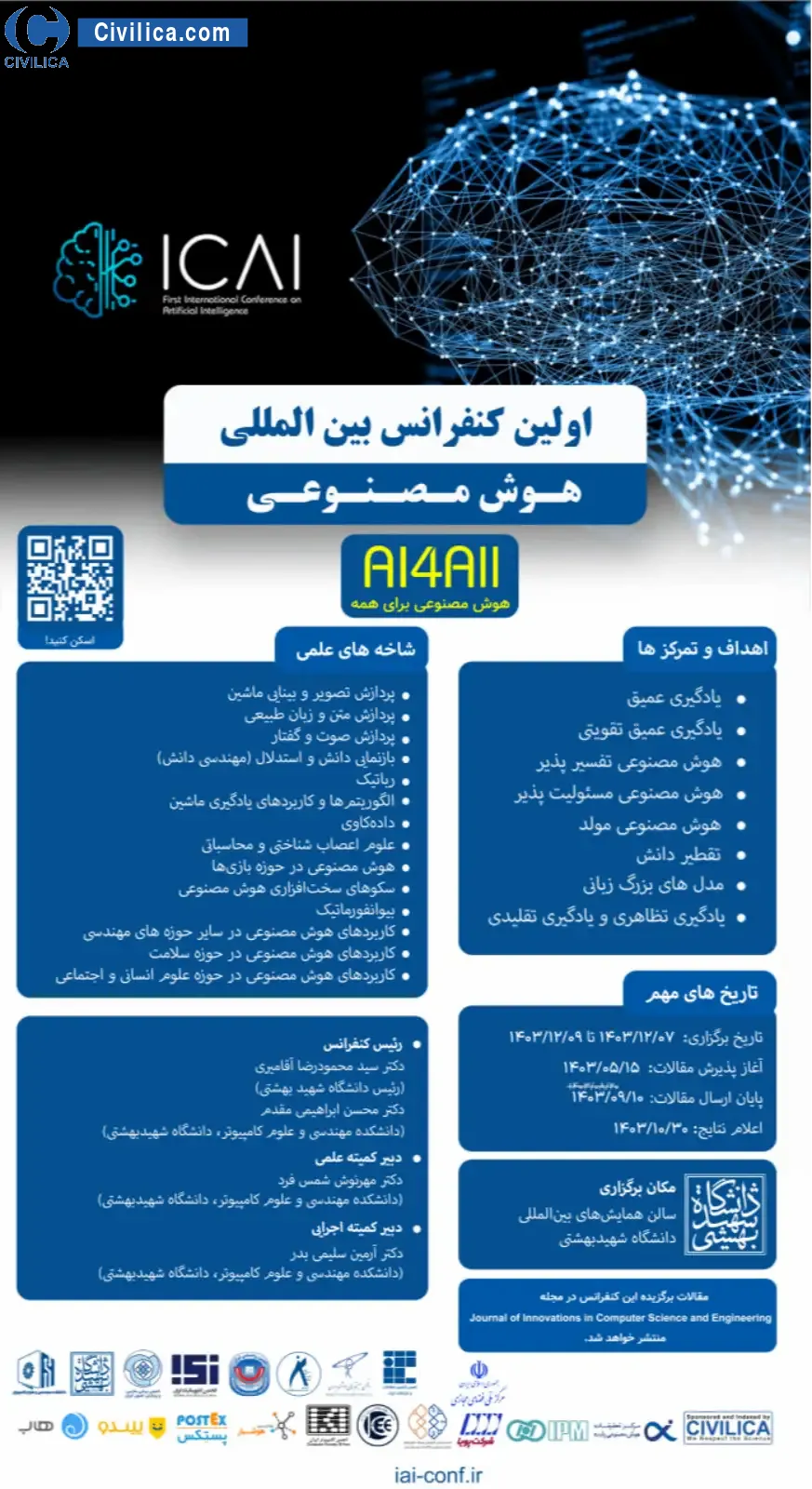- - هوش مصنوعی
انتشار مقالات اولین همایش بین المللی هوش مصنوعی
چهارشنبه، 31 اردیبهشت، 1404
1. Intermediate Fine-Tuning for Robust Persian Emotion Detection in Text
3. Efficient DL Models for Voice Pathology Detection in Healthcare Applications using Sustained Vowels
4. Advances in Deep Learning for Eye Disease Diagnosis: Applications, Challenges, and Future Directions
6. Deep Learning Frailty Model for Heart Failure Survival Prediction
8. Brain Age Classification from fMRI Data Using Graph Neural Networks and Evolutionary Algorithm
11. A Master-Slave Approach for Simultaneously Controlling Two Drones when Carrying an Object
12. Creating a Foundation for Dynamic Difficulty Adjustment within PCG of games using Imitation Learning
13. Simple Syntactic Sentences for NLP applications
15. Unlocking individual motor signatures using feature-based clustering of a graphomotor task
17. Automated Recognition of Marine Thermal Patterns Using Deep Learning
18. Exploring AI Techniques in the Identification and Control of Marine Vehicles
20. Predicting Damage States of RC Columns Using Machine Learning Algorithms
21. A Deep Reinforcement Learning Approach to Automated Stock Trading, using xLSTM Networks
22. A Hybrid Approach for Intrusion Detection in Computer Systems Using Optimized Deep Neural Networks
23. LDA-ML: A Hybrid DDoS Detection Attacks in SDN Environment using Machine Learning
24. Persian Intelligent Assistant in Healthcare Domain
26. Comparative Study of Criminal Responsibility of AI in the Legal Framework of Iran and Saudi Arabia
27. Empowering Businesses through AI: A Strategic Approach to Implementation
28. Improving the Quality of Life: The Experience of Women with MS from AI Chatbot Program
32. Data Mining's Role in Crafting Intelligent Recommender Systems: A Systematic Review
34. Predictive Modeling of Escherichia coli Growth: The Role of Key Cellular Features
36. A Systematic Review of Deep Learning Applications in Parkinson's Disease Research
38. White blood cell image analysis using CNN model
40. A Comprehensive Approach to Predicting Customer Churn with XGBoost
41. Enhancing IoT Data Prediction Accuracy Using Deep Learning and Metaheuristic Algorithms
42. Efficient and Accurate Fairness Verification for Quantum Variational Circuits
43. Enhancing IoT Data Prediction Accuracy Using a Hybrid Neural Network and Genetic Algorithm Approach
44. Aβ۴۲/۴۰ ratio prediction using MRI images features for Alzheimer's Early Detection
45. Hybrid ANN and Ant Colony Algorithm for IoT Data Classification
47. An Overview of the Application of Artificial Intelligence in Schools
48. Examining the Role of Artificial Intelligence in Enhancing Educational Equity: A Systematic Review
49. The Role of Ethics in Autonomous Decision Making: Advancements in Artificial Moral Agents
50. Strategies and Future Horizons of Innovative Entrepreneurship in AI-Based Programming
54. Generation for the Qur'anic chapters by summarizing them
اخبار مرتبط با کنفرانسها
- انتشار مقالات دومین کنفرانس بین المللی کارآفرینی اجتماعی و توسعه پایدار
- انتشار مقالات دومین کنفرانس بین المللی روانشناسی، علوم تربیتی، مدیریت و علوم اجتماعی
- انتشار مقالات هفتمین کنفرانس بین المللی مطالعات نوین در علوم انسانی، علوم تربیتی، حقوق و مطالعات اجتماعی
- انتشار مقالات اولین همایش راهبردهای تبیین پایداری اکوسیستم دریاچه نمک و کنترل گرد و غبار
- انتشار مقالات اولین همایش بین المللی پژوهش های تحول آفرین افسران پیشرفت ایران
- انتشار مقالات دومین کنفرانس بین المللی شهرسازی، معماری و فناوری های نوین شهری
- انتشار مقالات همایش ملی حقوق شهروندی با رویکرد حق سلامت و ارتقا کیفیت زندگی ایثارگران
- انتشار مقالات بیست و ششمین کنفرانس ملی روانشناسی علوم تربیتی و اجتماعی
- انتشار مقالات اولین همایش ملی هیدرولوژی و منابع آب ایران
- انتشار مقالات هفتمین همایش ملی زعفران ایران